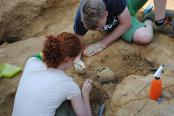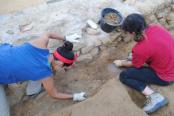CAMPAGNA 2017 |
1° SETTIMANA |
2° SETTIMANA |
3° SETTIMANA |
4° SETTIMANA |
5° SETTIMANA |
6° SETTIMANA |
7° SETTIMANA |
8° SETTIMANA |
26 GIUGNO 2017 
Resoconto della giornata di scavo
Area 2000
La convinzione di aver raggiunto un livello di suolo anantropizzato all’interno del saggio aperto nel settore Nord-Orientale si è rivelata sbagliata. Dopo aver esposto l’interfaccia uno strato sabbio-argilloso giallo-paglierino, sono infatti emerse le tracce di almeno una sepoltura e due altri tagli; di questi ultimi due, uno è una piccola buca di palo, che non ha restituito reperti, l’altra, non ancora scavata, appare tagliata dalla sepoltura sopracitata. Oggi abbiamo iniziato ad esplorare il taglio per l’inumazione e abbiamo messo in luce i due femori e parte di una tibia di un individuo presumibilmente ascrivibile alle primissime fasi di utilizzo del cimitero medievale.
We troweled the northwest back wall to be straight and flat so we could see the profile clearly. We sprayed the 3x3m section to expose soil difference and found burial outlines. Next we trowel cleaned in order to take a photo. We found 6 points of interest, including three possible burials with possible bone exposed in two. A 18.5cm post-hole with a diameter of 25cm was dug out, but nothing of interest was found within. We traced the boundaries of an area that seemed to have a semicircular shape that cut into the burial under the wall. This turned out to be part of the same burial cut, which we identified as USK 2781. We proceeded to excavate the bones using dental instruments, exposing a pair femora, and possible tibiae and pelvis. The second burial was determined to have no significance, uncovering a layer of sterile soil with iron inclusions.
Area 3000
Nella porzione centro-settentrionale del Settore B è stata completata la messa in luce e la successiva rimozione del cranio dell’individuo USK 3777, orientato W-E e deposto all’interno della fossa sepolcrale US – 3762. A sud, a ridosso del perimetrale meridionale USM 5003, è iniziata l’indagine della tomba US – 3769, orientata W-E e riempita da un sedimento prevalentemente argilloso di colore giallo-grigio e di consistenza abbastanza compatta, con piccole pietre e lastrine di scisto messe di piatto. Al di sotto di una di esse, più ad ovest, stanno emergendo i resti del cranio di un individuo, che ad una prima analisi sembrerebbe essere di giovane età. La messa in luce del resto del corpo dell’inumato sarà continuata domani, così come lo scavo del taglio di un’altra fossa sepolcrale, collocata più ad ovest.
Today in area 3000. The skull in context 3763 was fully exposed and then removed, a new grave along the southern border of the 12th century wall was opened, and the central area of sector B was cleaned and partially excavated. It is thought that the sex for the skull in 3763 was female because of its smaller mastoid process and less-prominant mental eminence. A context sheet was filled out to record all findings and general notes concerning the skull/cranium. The grave opened on the southern border of the 12th century wall is thought to be a subadult because of its small stature. Two small femurs were found, alongside with a smaller ilium. There were also a number of vertebrae found below another small bone potentially thought to be a clavicle. There was a small cranium found under a large slab of bluish rock (also found frequently as well as bluish fragments covering other portions of the grave). The cranium has yet to be exposed but seems to be crushed by previously removed other contexts. While cleaning the central part of sector B, part of the bell furnace was removed. A grave was emptied and nothing significant was found, potentially because of other graves cutting it (which were also empty)
Area 5000
Dopo lo scavo delle ultime evidenze emerse nel settore B abbiamo proceduto alla pulizia dell'intera area, utile alla documentazione fotografica e cartacea delle singole unità stratigrafiche. Ci siamo dunque potuti spostare nel settore C, che rappresenta la zona più meridionale dell'area 5000 in cui, nelle scorse campagne di scavo sono state individuate le fosse relative alla fusione delle campane di XI/XII secolo. Abbiamo quindi rimosso lo strato superficiale US 5024 che si estendeva su tutto il settore che ha messo in evidenza alcuni nuovi elementi che andranno analizzati e approfonditi. Una pulizia approfondita sarà necessaria nei prossimi giorni per poter individuare tutte le nuove evidenze stratigrafiche e non perdere importanti elementi utili per l'interpretazione dell'intera area di scavo.
Today we evened out section c with pickaxes, bringing it down to three or four centimeters above section b, then smoothed and cleaned section c. We discovered several more discolored spots in section c that are likely holes associated with the construction holes in section b. We also found several small locations within section c containing darker soil with small pebbles and cobbles ranging from a few milimeters to nine or ten centimeters in diameter as well as a single fragmentary human femur, situated vertically with the broken end of the diaphysis poking up out of the surface next to the eastern wall, most likely part of the fill from the construction of said wall.
Area 6000
Prosegue la rimozione dei riempimenti UUSS 6167, 6168 e 6169; rimozione particolarmente complessa per quanto riguarda i primi due a causa della estrema contiguità fisica tra il fondo della sepoltura meridionale (del riempimento US 6168) e la sommità di quella settentrionale (del riempimento US 6167). Sul lato ovest del settore continua lo scavo del riempimento US 6169.
We continued exposing and excavating the three burial features by identifying the cut and removing the burial fill. A portion of the lower extremeties (the feet and ankles) were exposed in feature 6168, which are associated with the upper portion of the skeleton exposed last week. The left arm and forearm were also exposed, which allowed the identification of the cut between feature 6168 and 6167. Additional pieces of slate were exposed in feature 6167 as well as skeletal elements within the burial fill. Continued removal of the burial fill within 6167 and 6169 was done to locate possible skeletal remains. Bone fragments and other artifacts (like pottery!) were collected and placed in bags to analyze later.















